A slice of Rajasthani heritage
‘Dharohar’, the heritage show comprising folk dances curated from all regions of Rajasthan is a veritable feast showcasing the essence and ethos of Rajasthani culture. The visual treat comes alive from a wide spectrum of folk arts and music from ignited minds of the organisers who have made it a tourist’s delight. The festivity which has enjoyed a pride of place in the hearts of eminent artists and heritage lovers, has fallen on tough times and needs funds for its revival.
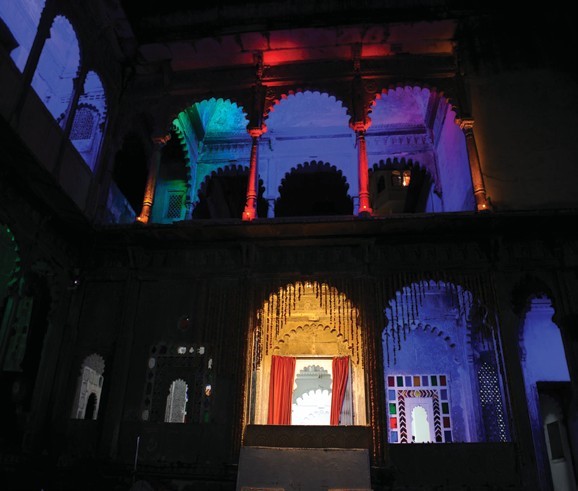 Bagore ki Haveli at Neem Chowk gets ready for the show
Bagore ki Haveli at Neem Chowk gets ready for the show
Evenings are a busy time at ‘Bagore Ki Haveli’, an imposing mansion located at Gangour ghat on the banks of the famous Lake Pichola in Udaipur, Rajasthan, one of India`s most popular tourist destinations. As an orange twilight envelops the heritage palace, the contours of balconies in its Neem Chowk, an open-air rectangular courtyard on the first floor of the Haveli come alive in prismatic colours, all under a star-lit sky. The musicians and singers are seated on a small platform along with a harmonium, dholak and other musical instruments. The audience is comfortably seated in the Chowk, and given a warm welcome to the beat of drums, blowing of a shankh (conch shell) and the song Kesariya Balam Padharo Mhare Des. A young lady anchor takes stage to give a brief introduction about the show in both English and Hindi. Female dancers clad in traditional costumes — bright coloured ghagras (long skirts with embroidered mirror work) and cholis (blouse) – saunter in whirling and twirling in sync, dancing to the beats of the live music. Slowly, Neem Chowk turns into a dazzling stage, as the audience soak themselves in the aesthetically rich and visually appealing live performances. The dance, the music and the entire stage settings are spectacular taking one’s breath away.
This is ‘Dharohar’, the heritage show comprising folk dances curated from all regions of Rajasthan, organised in association with the West Zone Cultural Centre (WZCC), headquartered at Bagore ki Haveli. The Haveli was built by Amar Chand Badwa, who was the prime minister of Mewar from 1751 AD – 1778 during the reigns of four Maharanas (Maharana Pratap Singh-II, Raj Singh, Ari Singh and Hamir Singh). Dharohar is today, one of the prime attractions for tourists visiting Udaipur.
The beginning of Dharohar
Two decades ago, tourists after spending a day at Udaipur’s palaces, gardens and lakes used to travel to neighbouring destinations overnight. Though extremely rich in folk arts and music, Udaipur had no musical entertainment for tourists that could lure them to spend an extra night in the lake city.
Deepak Dixit a former actor and theatre artist felt that there was a lot more that city could do to promote tourism and conceptualized ‘Dharohar’ to showcase the art, culture and heritage of Rajasthan. Born in Udaipur, Deepak had a deep inclination towards art and music since childhood. He regularly participated in the Youth Festival at his college and later worked briefly at Disha a theatre group founded by the legendary theatre artist Qaiyyum Ali Bohra. He has also acted in several Bollywood films – Love`86, Panaah (1992), Zid (1992), Khiladi (1992), Bedardi (1993), Kyun Ki Hum Deewane Hain (2001), besides television serials Dhola Maru (1995), Sanjog (1995) and Bhor Ko Aana Hi Hoga.
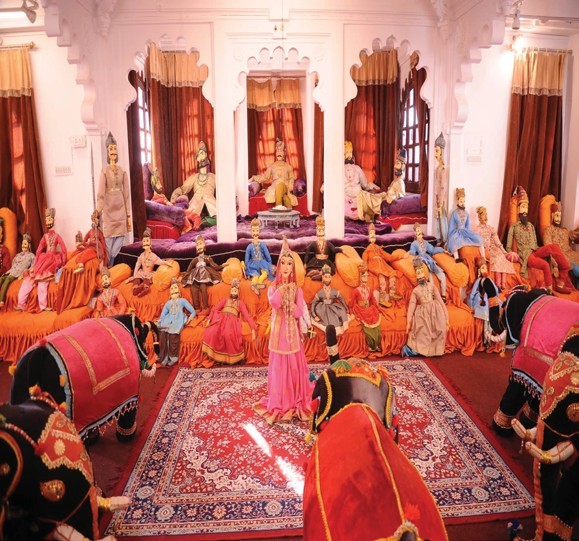 Puppets displayed at Bagore ki Haveli museum
Puppets displayed at Bagore ki Haveli museum
A multifaceted personality, Deepak has also penned short stories, essays on art and articles on environment. His official musical video song ‘Kabhi chirag jal gaye, Kabhi chirag bujh gaye’, directed by his kin Chinmay Dixit and composed during the lockdown period is popular among music lovers.
The West Zone Cultural Centre (WZCC) established in Udaipur in 1986 had been doing its bit to promote Rajasthan culture. The then Prime Minister Rajiv Gandhi organised a national event Apna Utsav to promote folk art and artists from all over the country. Deepak Dixit and his team performed at Apna Utsav in New Delhi. Aditi Mehta, the then Director of WZCC, Udaipur was highly impressed with his performance and invited him to join the Centre. It was during his association with WZCC as a Programme Officer for six years that idea of Dharohar took birth.
Deepak decided to offer a culturally rich, lively and immersive experience to the tourists by enveloping them in brilliant performances of folk dances, enthralling music of Rajasthan, and an entertaining puppet show – all under one roof.
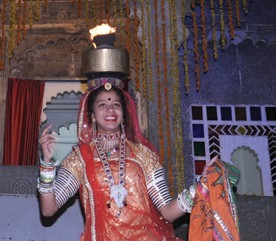 Chari dance performance by Tara Kamad, the youngest
Chari dance performance by Tara Kamad, the youngest
member of Dharohar
Dixit’s concept of establishing evening tourism at Bagore ki Haveli, by organising a folk-dance show performed by original village artists took shape with support of Dr. Vishwas Mehta, the then Director of West Zone Cultural Centre (WZCC). Professional folk artists residing in rural areas were pooled up for the show. The two collaborated and the first show of Dharohar was held at the Haveli on 28 October 2000. It was well received and since then there was no looking back.
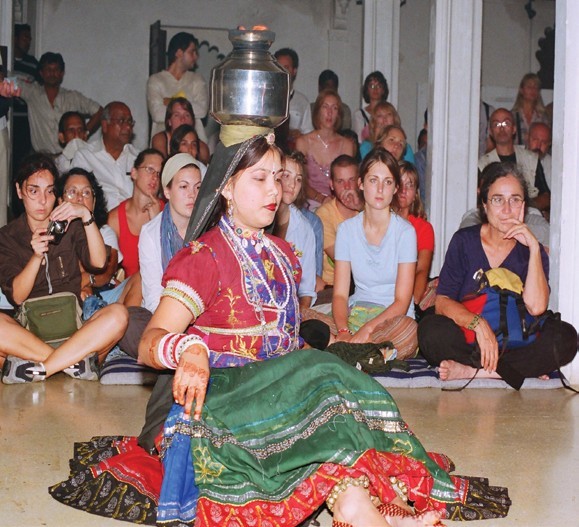 Foreign visitors to Udaipur watching Chari dance performance at Neem Chowk, the courtyard at Bagore ki Haveli
Foreign visitors to Udaipur watching Chari dance performance at Neem Chowk, the courtyard at Bagore ki Haveli
Dharohar has a dozen male artists, ten female artists and four back-end staff. The artists belong to different age groups and educational backgrounds, the youngest of them being Tara Kamad (19).
Says Deepak: “I founded Dharohar, but it is my wife Kirti Dixit (Co-founder & Director) who has been immensely contributing to its success for two decades. She is the invisible woman behind the stage who coordinates with the artists and their families and plays an important role in smooth flow of the event. She has an aesthetic eye for colours, ornaments and costumes. Besides designing costumes for the artistes, she ensures that tourists coming to Udaipur experience Dharohar and take back with them a slice of its cultural heritage”.
Dharohar’s repertoire
Dharohar’s repertoire includes six folk dances of the state, generally performed in the order given below:
Chari dance: It is a symbolic dance of ethnic Gujjar community from Northern Rajasthan. The costume of the dancers comprises ghagra – choli, both very colourful worn with a lot of traditional jewellery like hansli, timniya, mogri, panchi, bangdi, gajra, armlets, karli etc.
The Chari or Charu refers to a water pot made of metal. Often the Chari is set on fire with cotton seeds dipped in oil. The dancer balances these flaming pots on their head, without touching it, while performing a well-choreographed dance to the accompaniment of rustic music that comes from musical instruments like bankia, dhol, dholak, nagada and harmonium.
Gorband: The paraphernalia used in decoration of animals, particularly camels is called Gorband. The Gorband dance shows how women prepare a colorful Gorband for their domestic pet camel. It is a fun-filled dance performed by female dancers whirling around very fast to the rhythms of beats and music.
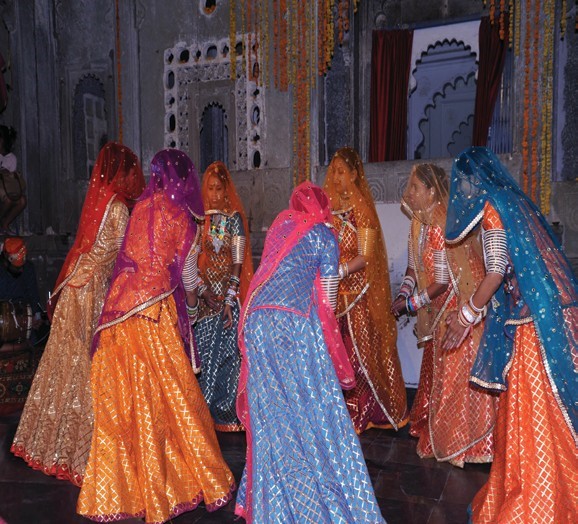 Veiled women performing Ghoomar, a traditional folk dance of Rajasthan
Veiled women performing Ghoomar, a traditional folk dance of Rajasthan
Gavri: A fusion of act and dance, it is always performed by male artists hailing from original Bhil tribe of Rajasthan. A vigorous fight between Goddess Amba and Demon Bhiamwal shows the conquest of good over evil. Though original Gavri is performed in villages, it is enacted in its dramatic form, only at Dharohar and perhaps nowhere else in Rajasthan.
Ghoomar: Ghoomar is a traditional dance form of Rajasthani royal families. Generally veiled women, wearing colorful ghagras, perform this dance. Traditionally, this dance was not performed in the presence of men. The costumes are adorned with Kundan, mirror and silver pieces of jewellery. The dancers rhythmically circle around a flock of dancers and pirouette while moving in and out of a wide circle. The pace of the music goes on increasing and with it the pace of the dance, till it reaches a crescendo and leaves everyone mesmerised.
Terah Taal: Generally, members of Kamad community perform Terah Taal during the nine days of the Navratri Festival, along with bhajans accompanied by music of the tanpura, dholak and manjira (brass cymbals) at temples. Terah means 13. In the Terah Taal, 13 manjiras are tied with rope on the bodies – on the legs, feet, hands and are played in 13 different ways.
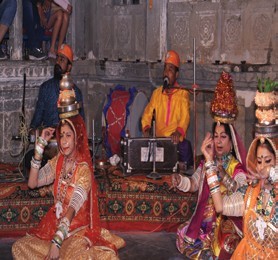 Tera Taal dance performance
Tera Taal dance performance
Puppet Show: The puppet show is one of the highlights of Dharohar and very popular with children. It used to be performed by the famous puppeteer Veni Lal Bhat since its inception until his death in 2020. His son Vrijesh Bhat now holds the puppet strings. Children from the audience are encouraged to take part in the show.
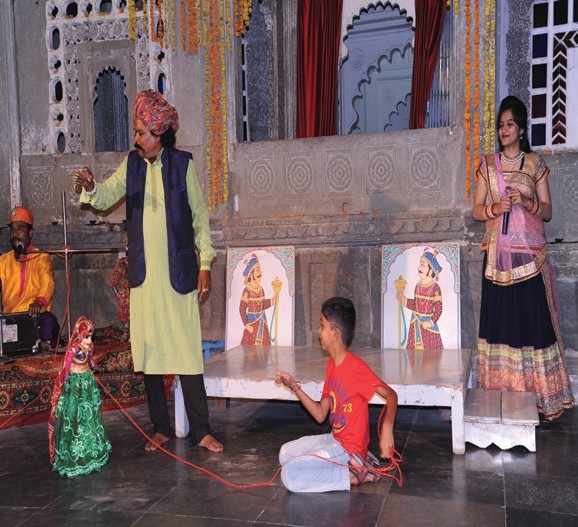 Puppet show conducted by the late Veni Lal
Puppet show conducted by the late Veni Lal
Bhavai: The Bhavai dance form has its origin in the western part of Rajasthan. The arid land suffers from extreme shortage of water and women have to walk miles in search of water; balancing four or five metallic vessels on their heads to fetch water from the wells. The joy of fetching water makes them forget the pain of carrying the weight over their heads. Rajasthani women often express their happiness in the form of Bhavai.
Women performing Bhavai are dressed in vibrant ghagras and short sleeved cholis, embellished with gota patti (appliqué / embroidery of Rajasthan) and mirror work, while colorful tassels hang around the sleeves. A dupatta draped along the head hangs down in a casual and graceful way. The short-sleeved choli leaves room for more adornment – the rest of the arm is covered with ornaments like bangles or armlets, at least a dozen of them on every arm!
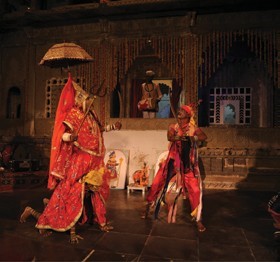 Gavri dance
Gavri dance
The artist steps onto the stage with three giant brass vessels. She picks up items from the floor with her mouth, while skillfully balancing the vessels on her head she dances on the edge of a metallic food plate and over the sharp cut pieces of glass. She goes on adding the vessels one by one till they become 10 in number.
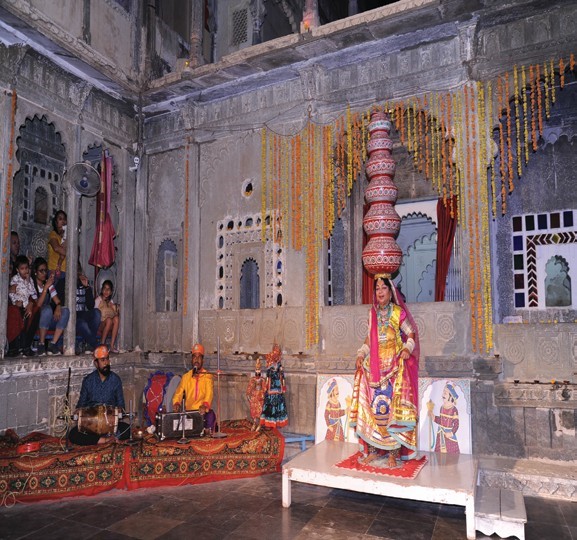 Bhavai dance being performed by the late Jaishree Rao
Bhavai dance being performed by the late Jaishree Rao
On festive occasions, other dances like the Peacock dance, Vishnu Chakr, Dang and Kalbelia are also performed by the regular artists of Dharohar as well as guest artists.
The Dharohar family
Deepak and Kirti have dedicated their life to crafting the show and making every single individual a flawless performer at Dharohar. Here, the emphasis is on the overall development of the individual. The institution has trained and propelled the artists to a brighter future in their life’s journey.
Himani Joshi and Mohita Joshi – during their long association with Dharohar were trained as anchors. Now they are renowned anchors presenting many programmes for the Government of India. Shubhi Sharma (anchor at Dharohar from March 2009 – May 2013 is now Bank Manager at ICICI, Udaipur), Kavya (renowned RJ at 94.3 MY FM Udaipur), Yojana Pandya, Chinmay Dixit, Yashu Dixit, Khushi, Sangeeta, Vimmy Rajpurohit and Nischay Soni are others members of the team who were trained at Dharohar and made it popular with their passion and hard work.
Ritu Sharma is a prominent anchor who joined Dharohar in 2009 and trained by Kirti is all praise for the platform which has shaped her career: “I joined Dharohar when I was studying in Class X. I was groomed by Kirti Madam. Dharohar is a one-hour live show which fills our lives with happiness every day. The team members feel a sense of pride in presenting and promoting the rich art and culture of our country through this show. We are a closely knit family and share our joys and sorrows. Be it a festival, or the anniversary of Dharohar or any other occasion, we celebrate every moment at Dharohar together”, she says.
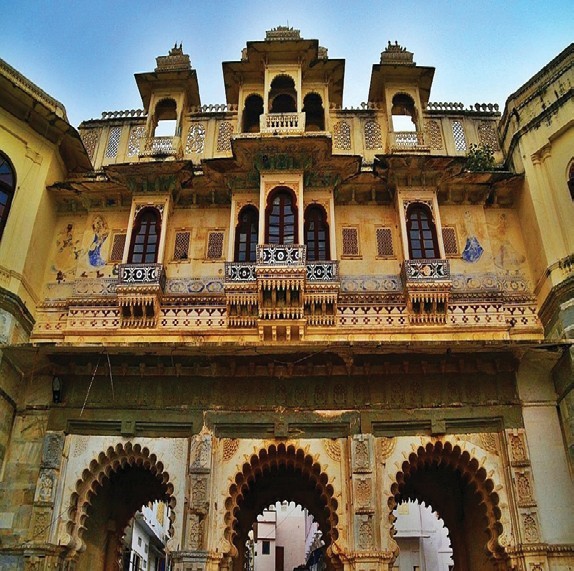 Bagore Ki Haveli Museum
Bagore Ki Haveli Museum
Journey down memory lane…
Dharohar has always enjoyed a pride of place in the hearts of eminent artists and heritage lovers. There is a not a single day when Neem Chowk is not packed with tourists – a testimony to Deepak Dixit’s vision. Film and television actors, delegation of Indian Army, art lovers, dignitaries and celebrities, et all have witnessed the show over the last two decades and showered their blessings on Dharohar.
Deepak Dixit recalls how Bollywood Director Shekhar Kapoor fell in love with Dharohar and took one of their senior most artist, 73-year-old Jaishree Rao to perform at Jag Mandir, The Lake Palace Hotel. Puppets made by Dharohar were used in the Salman Khan-Sonam Kapoor starrer Prem Ratan Dhan Paayo (2015). Dharohar’s artists have presented shows on foreign soil and won accolades in places as far as Scotland (2005), Kazakhstan (2016), Brazil, France, Australia, Paris and United States of America as well.
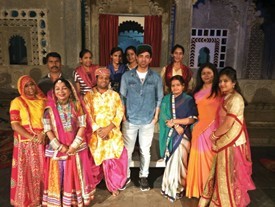 TV actor Maninder Singh with Dhanohar family
TV actor Maninder Singh with Dhanohar family
A rough road ahead for Dharohar
“It has been an eventful journey of 22 years” says Deepak with a sense of nostalgia. “Since we started in October 2000, we have performed a full show even for a single tourist. There were instances when tourists after watching our show came to us with tears of joy, feeling proud of our culture. Thus far we have hosted more than 7500 shows and still counting. We are looking forward to providing more platforms to our artists, so that more and more people get to witness our traditional folk dances”.
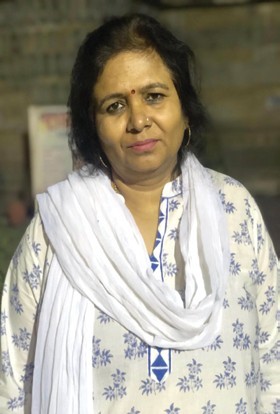 Kirti Dixit, wife of Deepak Dixit, who curates Dharohar show
Kirti Dixit, wife of Deepak Dixit, who curates Dharohar show
Dharohar has had its share of ups and downs in its eventful journey. Their famous puppeteer Veni Lal Bhat died in June 2020, leaving a big vacuum. Veni Lal was a master puppeteer who had perfect control on traditional marionettes (string puppets). Every puppet – whether it was the dancer (Anarkali), snake charmer, Sukli Julahi or Bengal Ka Jadoogar – would come alive in his hands and his puppetry show was a major attraction of Dharohar. Now the institution is grooming and supporting his young son Vrijesh Bhat and helping him hone his skills to replace his father.
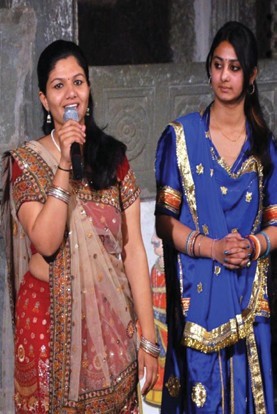 Anchors Himani Joshi and Khushi
Anchors Himani Joshi and Khushi
Jaishree Rao was Dharohar`s star performer. She had learnt dance from Padmashri Devi Lal Samar (Founder-director of a folk-theatre museum Bharatiya Lok Kala Mandal, Udaipur) and was an exponent of Bhavai. After spending almost two decades with Dharohar, she had quit to spend some peaceful time in her hometown in Tamil Nadu. It was a sad moment for Dharohar, when they received the news of her passing away 10-months ago.
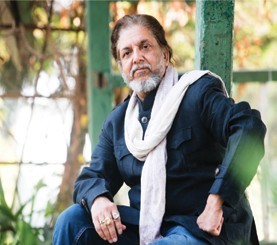 Deepak Dixit founder of Dharohar
Deepak Dixit founder of Dharohar
The corona pandemic has badly hit tourism in Udaipur, and Dharohar as well. The show remained closed for 10 months from March 2020 to January 2021. It was re-launched in January 2021, again closed in mid-March 2021 and reopened in the last week of October 2021. Since then the show is running with limited accommodation and a lukewarm response from the tourists.
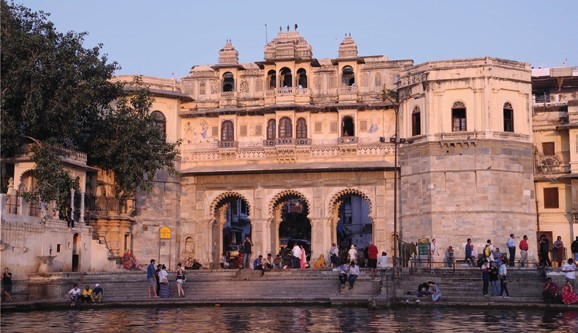 Gangaur Ghat
Gangaur Ghat
Says Deepak: “The only source of income for Dharohar is the revenue generated from the sale of tickets. Whatever marginal savings we had made over the years, were exhausted during the lockdown and we are facing a serious fund crunch. Today, Dharohar`s future hangs in the balance. The two big questions staring at us are: Where do we go from here in these times of crisis? And… how to maintain the pool of artists who have remained loyal to us for over two decades? We are hoping to see good times again and looking for maximum occupancy for every show to sustain Dharohar”. As Dharohar completes 22 years on 28 October this year, Deepak derives inspiration from the popular saying: “The show must go on.”


